You have an LED, but you don’t know which leg is positive and which one is negative. Well, LED leg polarity is precisely what we will explore in this article.
Straight away the short terminal of an LED is the cathode while the long terminal is the anode. This is true for new LEDs. But if the LED is a used one or its terminals of equal length, then the edge or trimmed side is the cathode.
If this short introduction has got your attention then I am sure you will enjoy the rest of this article as well.
Hi, I am Abbas. In the rest of this article, I will explain the above in great detail I will share how to check for the legs of the new LED. What to do when the terminals are of the same length? How to identify the terminals of used LEDs. We will look at the terminals or LED manual and I will also share a fun way to do so by using a special tool, and so much more.
I am not perfect nor this article is going to be. This is just my limited knowledge try to help you somehow.
I hope you will enjoy it.
Identify LED Leg Polarity
LED in electronics is short for a light emitting diode. It is a diode, but it can emit right upon the application of perfect bias voltage.
To properly define it, it would be like: An LED is a two terminal passive device that emits lights when biased in forward mode.
Following is the circuit symbol (on the left) and some physical LEDs of various colors.
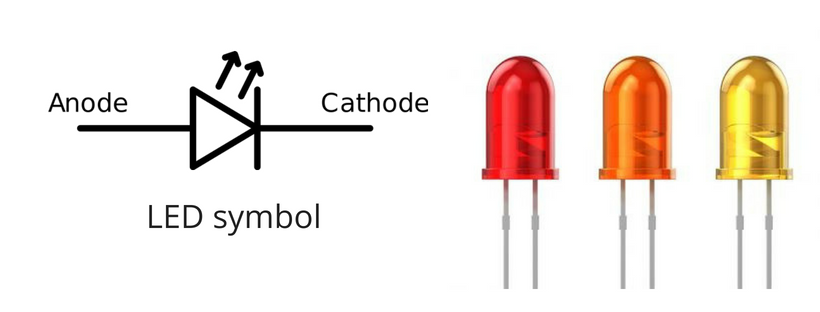
You know, as LED emits light we use it mostly for indication purposes, to light things up, for decoration purposes, sometimes for testing circuits, and so much more.
They come in various shapes, sizes, and various colors. I am sure you may have seen gorgeous lights in many places. They are a fascinating and absolute pleasure to the eyes.
But when you work with them, their terminal or leg polarity identification is what you may struggle with as a beginner. It’s so confusing to tell which leg is the anode and which is the cathode.
And if you do not take care of this, you ended up damaging your LED. Which is what we really don’t want to happen. To avoid this I have the following proven methods for you that will help you easily tell which leg of an LED is the anode (positive) and which is the cathode (negative).
Let’s see them in detail.
Manual LED Terminal Identification
This method is a manual one. Like you will do the inspection thing yourself to tell the right LED pin configuration.
Alright!
As I shared above an LED is basically a type of diode if you don’t connect the right terminals to the power supply it will not work. And in some cases, you may damage it permanently.
a. For new LEDs
You know, it is easy to identify the anode and cathode for a new LED. Because a new LED always comes with one leg longer than the other. See the following example for your reference.
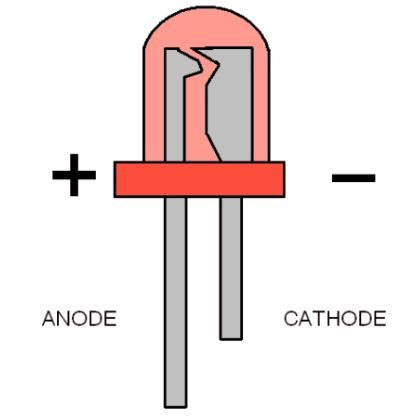
The longer leg is always the anode (positive) while the shorter is the cathode (negative).
So, if you are given a new LED. Just look for the long leg – this is your positive terminal, and you should always connect the positive terminal of the power source to it.
The short terminal is your cathode. You should connect it to the negative terminal of your power source in order for the LED to glow and operate properly.
b. For used LEDs
Now when a LED is already used in a circuit board the legs can not be trusted anymore. As the legs are cut out according to the requirements.
This can be true for off board LEDs as well if their legs are of the same length, or you are not sure about the length.
In the above cases look for the cut side of the LED. This trimmed or cut, or flat edge side is always the negative cathode. See the following example for your understanding.
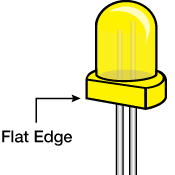
I would recommend getting yourself some LEDs and doing some experiments with them. That is the only way you will learn the concepts I shared.
Automatic LED Terminal Identification
The above method requires careful readings and examination. And it is subjected to human errors.
Let me tell you something interesting. The above methods are true and easy for round LEDs. But when you work with a lot of different shapes of LED, and different terminals (like 3 or 4 terminals) it would be really hard to identify the right pins.
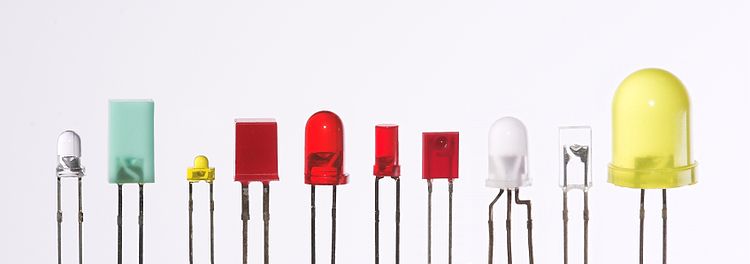
In all these cases the above methods become limited. And we need a proper tool to just tell us everything about our LED no matter what terminal, shape, rating, or size.
I am not saying the above methods are bad or something. I am just saying we have an easy alternative to the above – that simple.
This method requires a new tool called the component tester. This component tester is an amazing and fun tool to have in our labs. It makes our lives easy and most importantly, it saves us a lot of valuable time.
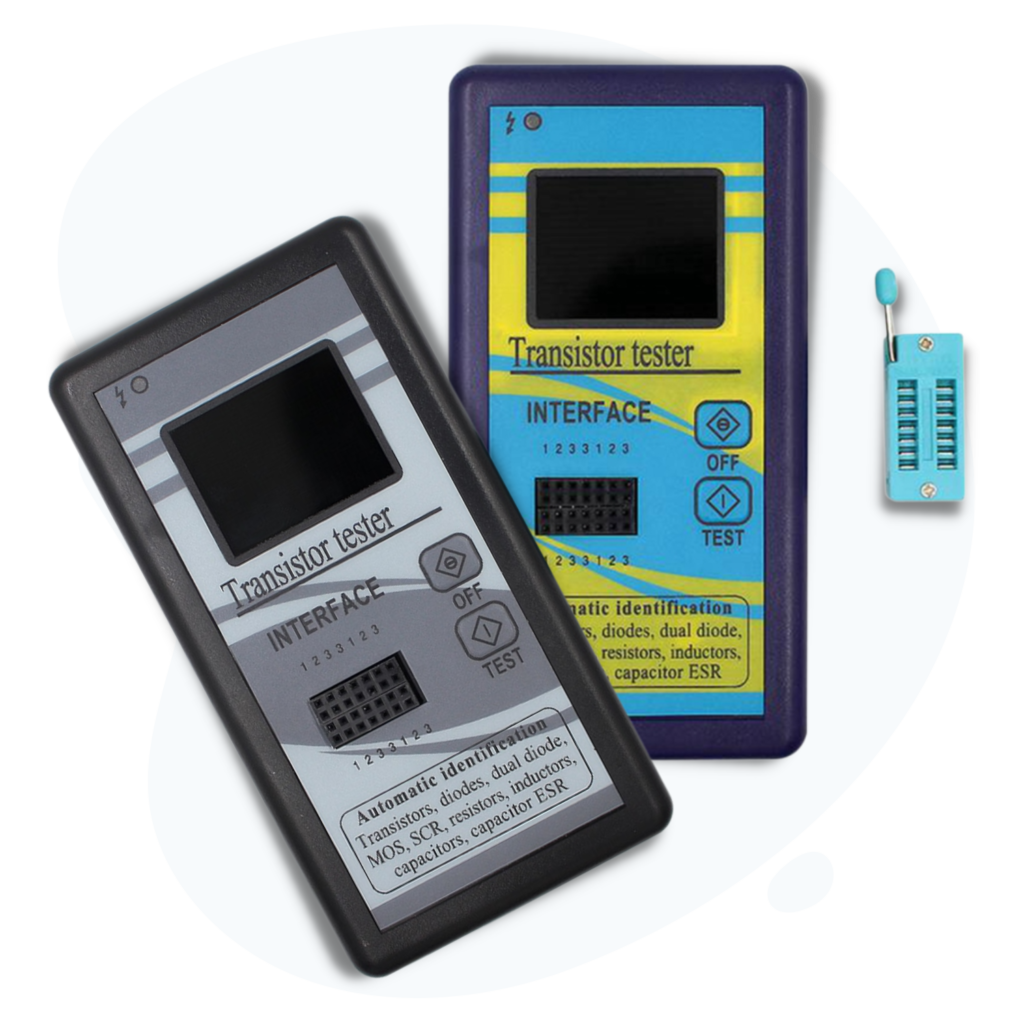
Alright!
Following are the steps to use this tool for any LED legs polarity identification:
- Turn on the tester
- Place your LED you want to test
- Press test button
- See the results on the screen.
- The tester will exactly tell you which terminal is the anode and which terminal is the cathode.
- But there is so much more
- If the LED is fine you will see a forward voltage drop of 0.7V for Si and 0.3V for Ge.
- If the LED is bad you will see no results – it is that easy.
As this method seems interesting. You should try this definitely. This method not only tells you about the correct pin configuration of LEDs but also helps us to test the LED as well.
By testing, I mean to tell you if the LED you are working with is a good one or a bad one. Thus saving us a lot of time and lab resources.
Now, if the component tester mentioned above has got you curious and wants to know more about it. Here is the link, M328 Component Tester (Amazon link), for your own further research and investigation.
Conclusion
When it comes to indication LED is our first choice. It helps us show the state of a device. It helps us design cool and fun circuits and so much more.
The question is what is an LED? Basically, an LED is a passive semiconductor device that emits light when forward biased. Think of it as one of the types of a diode, but it glows upon the application of the right voltage.
When you are a beginner and start working with LEDs. It is really confusing to identify the right LED leg polarity. I mean to tell which leg is the anode and which leg is the cathode.
In this article, we just answer this question in detail. But to just briefly summarize it – it is like the longer leg of an LED is the anode while the short leg is the negative cathode. This is true for a new LED. But when we have LEDs of the same length, or it is an old one then we look at trimmed or cut edge. This cut side is the cathode and the other one is the anode.
So that is it. That is all I have for you about the LED leg polarity. I hope you enjoyed my little effort, and you found the exact answer you were looking for. If not, please share in the comment I will be there to help you more to the best of my abilities.
Thank you and have grateful life.
Other useful posts:
- Resistor basics & testing (Easy step by step guide)
- Learn about LED in electronics (Easy basics guide)
- Where do I start with electronics? (Simple answer)
- Can I learn electronics on my own? (Simple Answer)
- How to Identify Electronic Components (Easy Solution)
- Electronic Components Testing (Step by Step Guide)
